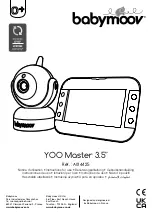
®
Procedure
PS-3218
5
013-15878A
above the elbow with the two tubes hanging down (one on
each side of the arm).
Use the hook-and-pile material to hold the cuff in place.
Position the cuff's bottom edge at about 2.5 cm (one inch)
above the elbow pit.
Rotate the cuff as needed to position the white index line
(labeled ARTERY) on the cuff over the main artery
(brachial artery) on the inside of your left arm.
Procedure
Partner 1 should sit without crossing your legs. Relax. Rest
your left elbow and forearm on a solid surface with your
palm facing upward. The cuff should be slightly lower than
your heart.
Partner 2 should press and hold the push-button release
valve to make sure that all of the air in the cuff has been
released.
In the data collection software, set up Digits displays of
pressure, diastolic pressure, and systolic pressure. You
may also want to view pressure versus time on a Graph
display.
The patient should stay as still as possible during the blood
pressure measurement. Do not talk or move if possible.
Partner 2 should press “Start” or “Record” to begin data
collection and then use the bulb to pump air into the cuff.
Monitor the pressure in the Digits displays. When the
pressure reaches approximately 170 mmHg, partner 2
should stop pumping and let go of the bulb.
When the cuff is deflated, press “Stop” to end data
collection. After the measurement is finished, release the
remaining air in the cuff by pressing the push-button
release valve on the bulb and holding it for several
seconds. You should be able to hear air coming out of the
cuff.
(See
Appendix A: Sample Data
.)
Mounting the Sensor
The Wireless Blood Pressure Sensor housing includes a
threaded hole (1/4-20) on one side. Screw a PASCO
Mounting Rod (ME-9483 10 pack) into the threaded hole,
and use clamps and support rods to hold the sensor in
place.
About the Battery
The Wireless Blood Pressure Sensor’s battery is partially
charged at the factory. If the battery status LED blinks red,
use the micro USB cable to connect the sensor to a USB
port or a USB charger.
Battery Usage
Battery life is very important to making the sensor simple
and always ready to use, so all of the PASCO wireless
products are designed for long battery life. For example,
the sensor turns itself off after a few minutes of inactivity.
The battery life between charges for the Blood Pressure
Sensor varies depending on the sampling rate. The battery
life ranges between 11 hours for high sample rates to more
than 70 hours for low sample rates.
In typical classroom/lab use, this would translate to a
battery life between charges ranging from one to four
weeks or more, because full-day continuous sampling
would be unusual. Even in the most extreme case with a
high sample rate, the Blood Pressure Sensor battery would
support a full day of use before needing to recharge.
Maximizing Battery Life
One factor that affects battery life is the storage
temperature and the number of charge cycles. Therefore,
avoid storing the sensor in very cold or very hot
environments.
Related Products
Other physiology sensors include the following:
•
Wireless Hand Grip Heart Rate Sensor PS-3206
•
Wireless Exercise Heart Rate Sensor PS-3205
•
PASPORT EKG Sensor PS-2111
•
PASPORT Spirometer PS-2522
Suggested Experiments
See the PASCO Web site at
www.pasco.com/products/lab-manuals
for more information about experiments.
CAUTION: Do not pump above 200 mmHg.
If there is discomfort, push and hold the push-button on
the release valve to deflate the cuff.
NOTE:
The pressure in the cuff will decrease
automatically (at about 3 mmHg per second) so the cuff
will slowly deflate by itself in about a minute
.



























